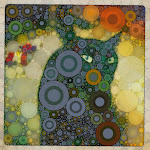 |
| Hacquetia epipactis |
I mean the madness that engulfs me every year as plants begin to break dormancy and bulbs push their way out of the soil. I mean the madness of checking the garden twice a day to see what's progressing. It's madness because we are just approaching the official start of Spring, we are still having morning frosts occasionally, and the soil has barely warmed at all.
Still…
I could blame the snowdrops and Iris reticulata—they have already bloomed (although some snowdrops are still in bloom). Hellebores have be going strong for several weeks now, including "Ivory Prince," seen with the Hacquetia epipactis in the first photo. We had several of these in our Vashon Island garden; this one was in a container, so it came with us to the new house in 2010. It's a reliable performer, sending up ever-larger clumps of blooms each year. We remove all of last year's foliage when the flower stalks emerge; new, fresh foliage will form soon.
The little charmer in the forefront is Hacquetia epipactis, a charming little oddity that pushes its "flowers" directly out of the ground until a low mound of color forms. The only species in its genus, it prefers moist woodland settings and spreads gently by both rhizomes and self-seeding, although never thuggishly. We have these tucked under the skirts of a hardy fuchsia, which offers some protection from late summer sun.The "flowers" are actually just the yellow centers; the "petals" are actually sepals. In any case, it is a fabulously fresh color for early spring.
 |
| Brunnera macrophylla 'Jack Frost' |
As the cloud develops, new leaves push up, green with an incredible overlay of silver patterning. In our Vashon Island garden, we had many of these as they prefer at least part shade and are unpalatable to deer, perhaps because their leaves are stiff and rough. We have one in our small shade bed and two in a bed that gets more sun. Unfortunately, they get too much sun later in the summer and they burn to a crisp. Perhaps this will be the year we get around to moving them to a more shaded position so they look great until fall.
 |
| Helleborus x hybridus |
The Helleborus argutifolius that was here when we bought the house bloomed spectacularly last winter and spring, with mounds of acid green flowers over the toothed glue-grey leaves. Then, we moved it.
We really had no choice. We completely redid the front yard, and anything we wanted to save we had to dig and either pot or plant elsewhere. This hellebore sulked all summer, although it didn't die outright, and it didn't bloom this year. However, new growth is sprouting from the roots, so we've cut down all the old tatty foliage and will see what happens. This plant produced one seedling last year, which is happily growing in one of the new beds in the front garden. In our makeshift nursery (we all have them, no?) we have about a dozen little hellebore seedlings coming along in 4-inch pots. Who knows what colors they will be? You never really know with hellebore seedlings until they bloom. We will probably plant these out in the new beds later this spring.
 |
| Hyacinthus orientalis 'Jan Bos' |
These are happy at the foot of a Mahonia x intermedia 'Charity' and are surrounded by a sea of Sedum 'Angelina,' which is just taking off for the season.
Next up—lots and lots of narcissus, three kinds of species tulips, chionodoxa, leucojum, and parrot tulips, followed by alliums, eremurus, and lilies. By the time the lilies are up, peonies will be surging toward bloom, along with hardy geraniums. The madness of waiting impatiently will give way to the thrill of full beds and problems revealed.


